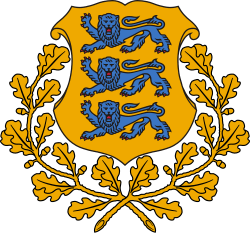List of heads of government of Estonia
This is a list of people, who have been heads of government of the Republic of Estonia from 1918, either as a Chairman of the Council of Elders (1918), Prime Minister (1918-1920; 1934-1940 and from 1990), State Elder (1920–1934) or President-Regent (1937–1938). The office of Prime Minister (Peaminister) first came into use soon after Estonia gained its independence in 1918. From 1918 to 1934, Estonia used a parliamentary political system, where the presidency and ministry were subject to parliamentary confidence, but instead of a presidential office, the government was headed by a Prime Minister and from 1920 to 1934, a similar office called State Elder (Riigivanem).
The 1934 constitution gave the State Elder the role of the president, with a separate head of government created, restoring the office of Prime Minister. The new system was obstructed by a 1934 coup d'état by head of government Konstantin Päts. During his authoritarian era (1934–1937), he ruled as both Prime Minister and State Elder. The latter office was entrusted to him briefly until the presidential elections. In 1937, the two offices were combined into the office of President-Regent (Riigihoidja), but the situation was again changed with the 1938 constitution, when Konstantin Päts gave up the office of Prime Minister to a new officeholder.
The Soviet occupation of Estonia in 1940 made Johannes Vares the new Prime Minister of Estonia, but his rule was later declared to have been illegal. According to the 1938 constitution, Prime Minister was to lead the presidency in case the President couldn't be elected, a move that was implemented for the Estonian Government in Exile. The interim government restored the office of Prime Minister in 1990.
List of heads of government
| Portrait | Name | Term of Office | Political Party | Cabinet | Riigikogu (Election) |
Separate Head of State | |||
|---|---|---|---|---|---|---|---|---|---|
| Took Office | Left Office | Days | |||||||
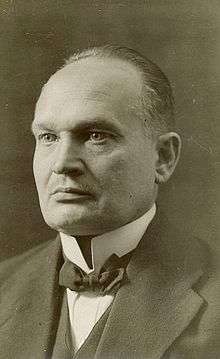 |
Konstantin Päts (1874–1956) Chairman of the Council of Ministers of the Provisional Government |
24 February 1918 | 12 November 1918 | 440 | Country People's Union (EMRL) |
Päts I Provisional EMRL–ETE–EDE–ESDTP |
Provisional Provincial Assembly (1917) |
None | |
| Prime Minister of the Provisional Government |
12 November 1918 | 27 November 1918 | Päts II Provisional EMRL–ETE–EDE EMRL–ETE–EDE–ESDTP [Note 1] | ||||||
| 27 November 1918 | 9 May 1919 | Päts III Provisional EMRL–ETE–EDE–ESDTP EMRL–ETE–EDE–ESDTP–SEE EMRL–ETE–EDE–ESDTP–SEE–VKK EMRL–ETE–ERE–ESDTP–SEE–VKK [Note 2] | |||||||
| Declaration of Independence by the Estonian Salvation Committee of the Council of Elders of the Estonian Provincial Assembly (24.02), effective in Tallinn and a few other places. Appointment of the Estonian Provisional Government (24.02), followed by German occupation (25.02–11.11). Disappearance (28.03) and likely execution (2.05) of Deputy Chairman of the Council of Ministers and Minister of Courts Jüri Vilms in Finland. British (3.05), French (13.05) and Italian (29.05) provisional de facto recognition of the underground Estonian Provisional Government. Imprisonment of Päts in German-occupied Estonia, Latvia and Belarus (11.06–17.11). Underground activity headed by Minister of Foreign Affairs and acting Deputy Chairman of the Council of Ministers Jaan Poska (from 11.06). German handing over of de facto power to the Estonian Provisional Government (11.–14.11). Founding of the Defence League (11.11).
Appointment of Päts II Provisional Government cabinet with renewed ministerial portfolios (12.11), provisionally headed by Deputy Prime Minister Jaan Poska. Founding of the Defence Forces (12.11). German provisional de facto recognition of Estonian independence (19.11) and handing over of de jure power to the Estonian Provisional Government (19.–21.11). Return of Päts from imprisonment in German-occupied Belarus (20.11). Appointment of Päts III Provisional Government cabinet with renewed ministerial portfolios (27.11). The Provisional Provincial Assembly temporarily delegated legislative power to the Provisional Government (27.11). Russian SFSR invasion of Estonia and beginning of the Estonian War of Independence (28.11). Dual power with the Commune of the Working People of Estonia (29.11.1918–31.01.1919). Delivery of first foreign loan of 10 million Finnish markka from Finland (10.12). British naval (from 12.12) and Finnish (from 30.12), Swedish (from 13.02.1919) and Danish voluntary assistance (from 4.04) in the war. Successful Estonian counteroffensive (from 7.01). Annexation of Ruhnu Island into Estonia (17.01). Liberation of Estonian territory (by 31.01). Suppression of an anti-war revolt in Saaremaa (16.–21.02). Alliance treaty with Latvia (18.02). Loss of power to left-wing parties at the 1919 elections (5.–7.04). Resigned after the convening of the Estonian Constituent Assembly (23.04). | |||||||||
| Otto August Strandman (1875–1941) 1st Prime Minister |
9 May 1919 | 18 November 1919 | 194 | Labour Party (ETE) |
Strandman I ETE–ESDTP–ERE ETE–ESDTP [Note 3] |
Constituent Assembly (1919) | |||
| First cabinet appointed after elections in independent Estonia. War against the Baltische Landeswehr (5.06–3.07). Adoption of the temporary regime of government (4.07). The Estonian People's Party (ERE) left the coalition (20.09) due to opposition to the radical Rent Act and Land Act bills. Adoption of the radical land reform confiscating and redistributing the mostly Baltic German estates (10.10). Disarmament of White movement forces in Estonia (from 11.11). Resigned without explanation (11.11) after failure to renew the coalition. | |||||||||
 |
Jaan Tõnisson (1868–1941?) 2nd Prime Minister |
18 November 1919 | 28 July 1920 | 254 | People's Party (ERE) |
Tõnisson I ERE–ETE–ESDTP ERE–ETE–(ESDTP) [Note 4] | |||
| Peace talks with the Russian SFSR (from 5.12). Tensions with Latvia due to a border dispute (24.12.1919–22.03.1920). Signing (31.12.1919) and implementation (3.01.1920) of an armistice with the Russian SFSR. Signing (2.02) and ratification (13.02) of the Tartu Peace Treaty, ending the War of Independence and mutually first recognition of the independence of Estonia and the Russian SFSR. Finnish recognition of Estonian independence (7.06). Adoption of the Abolition of Nobility Act (9.06). Adoption of the first constitution (15.06). The Estonian Social Democratic Workers' Party (ESDTP) left the coalition (1.07) due to the government's "bourgeois" politics, while its ministers remained in office. Establishment of the Estonian-Latvian border (1.–3.07). Resigned after failing to replace ESDTP as a coalition partner. | |||||||||
| Ado Birk (1883–1942) 3rd Prime Minister |
28 July 1920 | 30 July 1920 | 3 | People's Party (ERE) |
Birk ERE–ETE–KRE | ||||
| Minority government which resigned on the same day and never took office, but was not immediately replaced by the Riigikogu. Previous Prime Minister Jaan Tõnisson was nominated acting Prime Minister (29.07) and was voted into office the next day. Birk cabinet remains the shortest in Estonian history. | |||||||||
 |
Jaan Tõnisson (1868–1941?) 4th Prime Minister (2nd term) |
30 July 1920 | 26 October 1920 | 89 | People's Party (ERE) |
Tõnisson II ERE | |||
| Ants Piip (1884–1942) 5th Prime Minister |
26 October 1920 | 20 December 1920 | 92 | Labour Party (ETE) |
Piip ETE | ||||
| 1st State Elder | 20 December 1920 | 25 January 1921 | |||||||
 |
Konstantin Päts (1874–1956) 2nd State Elder (2nd term) |
25 January 1921 | 21 November 1922 | 666 | Farmers' Assemblies (PK) |
Päts I PK–ETE–ERE–KRE PK–ERE–KRE [Note 5] |
I (1920) | ||
| Juhan Kukk (1885–1942) 3rd State Elder |
21 November 1922 | 2 August 1923 | 255 | Labour Party (ETE) |
Kukk ETE–PK–ERE ETE–PK–(ERE) [Note 6] | ||||
 |
Konstantin Päts (1874–1956) 4th State Elder (3rd term) |
2 August 1923 | 26 March 1924 | 238 | Farmers' Assemblies (PK) |
Päts II PK–KRE–ERE–ETE PK–KRE–ERE |
II (1923) | ||
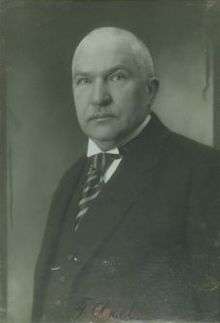 |
Friedrich Karl Akel (1871–1941) 5th State Elder |
26 March 1924 | 16 December 1924 | 266 | Christian People's Party (KRE) |
Akel KRE–ETE–ERE | |||
| Jüri Jaakson (1870–1942) 6th State Elder |
16 December 1924 | 15 December 1925 | 365 | People's Party (ERE) |
Jaakson ERE–PK–ESDTP–ETE–KRE ERE–PK–ESTP–ETE–KRE [Note 7] | ||||
| Jaan Teemant (1872–1941?) 7th State Elder |
15 December 1925 | 23 July 1926 | 725 | Farmers' Assemblies (PK) |
Teemant I PK–ETE–KRE–ARVK PK–ETE–KRE–ARVK–RVP | ||||
| 23 July 1926 | 4 March 1927 | Teemant II PK–ARVK–KRE–ERE–ÜMSL |
III (1926) | ||||||
| 4 March 1927 | 9 December 1927 | Teemant III PK–ARVK–ERE–KRE–ÜMSL | |||||||
 |
Jaan Tõnisson (1868–1941?) 8th State Elder (3rd term) |
9 December 1927 | 4 December 1928 | 362 | People's Party (ERE) |
Tõnisson III ERE–PK–ARVK–ETE | |||
| August Rei (1886–1963) 9th State Elder |
4 December 1928 | 9 July 1929 | 218 | Socialist Workers' Party (ESTP) |
Rei ESTP–ARVK–ETE–KRE | ||||
| Otto August Strandman (1875–1941) 10th State Elder (2nd term) |
9 July 1929 | 12 February 1931 | 584 | Labour Party (ETE) |
Strandman II ETE–ARVK–PK–KRE–ERE |
IV (1929) | |||
 |
Konstantin Päts (1874–1956) 11th State Elder (4th term) |
12 February 1931 | 19 February 1932 | 373 | Farmers' Assemblies (PK) |
Päts III PK–ERE–ESTP | |||
| Jaan Teemant (1872–1941?) 12th State Elder (2nd term) |
19 February 1932 | 19 July 1932 | 152 | Union of Farmers' Assemblies, Farmers, Settlers and Smallholders (PK/PAVK) |
Teemant IV PK/PAVK–RKE | ||||
| Karl August Einbund (later Kaarel Eenpalu) (1888–1942) 13th State Elder |
19 July 1932 | 1 November 1932 | 106 | Union of Farmers' Assemblies, Farmers, Settlers and Smallholders (PK/PAVK) |
Einbund I PK/PAVK–RKE [Note 8] |
V (1932) | |||
 |
Konstantin Päts (1874–1956) 14th State Elder (5th term) |
1 November 1932 | 18 May 1933 | 199 | Union of Farmers' Assemblies, Farmers, Settlers and Smallholders (PK/PAVK) |
Päts IV PK/PAVK–RKE–ESTP | |||
 |
Jaan Tõnisson (1868–1941?) 15th State Elder (4th term) |
18 May 1933 | 21 October 1933 | 157 | National Centre Party (RKE) |
Tõnisson IV RKE–PAVK | |||
 |
Konstantin Päts (1874–1956) 16th State Elder |
21 October 1933 | 24 January 1934 | 1,647 | Farmers' Assemblies (PK) [Note 9] |
Päts V non-party coalition [Note 10] | |||
| 6th Prime Minister (in duties of the State Elder) |
24 January 1934 | 3 September 1937 | Prime Minister in duties of the State Elder Konstantin Päts | ||||||
| None [Note 11] |
Parliament disbanded [Note 12] | ||||||||
| President-Regent (6th term) |
3 September 1937 | 24 April 1938 | None | ||||||
| Kaarel Eenpalu (formerly Karl August Einbund) (1888–1942) Acting Prime Minister |
24 April 1938 | 9 May 1938 | 537 | None [Note 11] |
Päts V (continued) non-party coalition [Note 10] |
President Konstantin Päts (1938–1940) | |||
| 7th Prime Minister (2nd term) |
9 May 1938 | 12 October 1939 | Eenpalu II non-party coalition [Note 8] |
VI (1938) | |||||
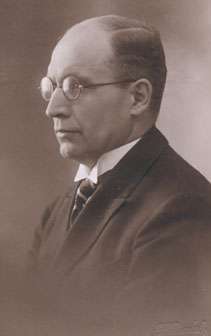 |
Jüri Uluots (1890–1945) 8th Prime Minister |
12 October 1939 | 21 June 1940 [Note 13] |
254 | None [Note 11] |
Uluots non-party coalition | |||
| 1st Soviet Occupation (1940–1941) | |||||||||
| German Occupation (1941–1944) | |||||||||
| Otto Tief (1889–1976) Acting Prime Minister |
18 September 1944 [Note 14] |
25 September 1944 [Note 15] |
8 | None | Tief non-party coalition |
Parliament disbanded |
Prime Minister in duties of the President Jüri Uluots [Note 16] | ||
| 2nd Soviet Occupation (1944–1991) (See Estonian Government in Exile) | |||||||||
 |
Edgar Savisaar (b. 1950) 1st Prime Minister of the Interim Government |
3 April 1990 [Note 17] |
29 January 1992 | 668 | Popular Front of Estonia (ERR) [Note 18] Estonian People's Centre Party (ERKE) |
Savisaar Interim various coalition partners |
Supreme Soviet (1990) [Note 19] |
Chairman of the Supreme Soviet | |
| Chairman of the Supreme Council Arnold Rüütel [Note 19] | |||||||||
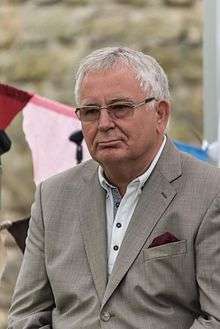 |
Tiit Vähi (b. 1947) 2nd Prime Minister of the Interim Government |
29 January 1992 | 21 October 1992 | 266 | None | Vähi Interim various coalition partners | |||
| President Lennart Georg Meri (1992–2001) [Note 20] | |||||||||
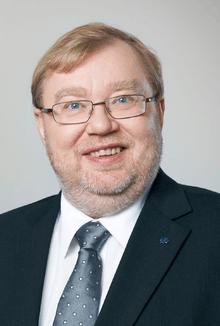 |
Mart Laar (b. 1960) 9th Prime Minister |
21 October 1992 | 8 November 1994 | 749 | Pro Patria (I) [Note 21] Pro Patria National Coalition Party (RKEI) |
Laar I I–M–ERSP |
VII (1992) | ||
 |
Andres Tarand (b. 1940) 10th Prime Minister |
8 November 1994 | 17 April 1995 | 161 | Moderates (M) [Note 22] |
Tarand M–RKEI–ERSP–ELDP–VKRE [Note 22] | |||
 |
Tiit Vähi (b. 1947) 11th Prime Minister (2nd term) |
17 April 1995 | 6 November 1995 | 701 | Coalition Party and Country People's Alliance (KMÜ) |
Vähi I KMÜ–EKE |
VIII (1995) | ||
| 6 November 1995 | 17 March 1997 | Vähi II KMÜ–ERE KMÜ–AP | |||||||
| Mart Siimann (b. 1946) 12th Prime Minister |
17 March 1997 | 25 March 1999 | 739 | Coalition Party and Country People's Alliance (KMÜ) |
Siimann KMÜ–AP | ||||
 |
Mart Laar (b. 1960) 13th Prime Minister (2nd term) |
25 March 1999 | 28 January 2002 | 1,041 | Pro Patria Union (IL) |
Laar II IL–RM–ERE |
IX (1999) | ||
| President Arnold Rüütel (2001–2006) [Note 20] | |||||||||
| Siim Kallas (b. 1948) 14th Prime Minister |
28 January 2002 | 10 April 2003 | 438 | Reform Party (ERE) |
Kallas ERE–EKE | ||||
 |
Juhan Parts (b. 1966) 15th Prime Minister |
10 April 2003 | 12 April 2005 | 735 | Res Publica Party (RP) |
Parts RP–ERE–ERL |
X (2003) | ||
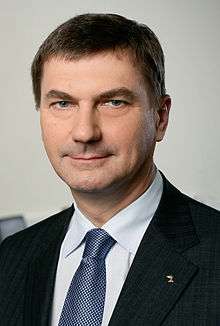 |
Andrus Ansip (b. 1956) 16th Prime Minister |
12 April 2005 | 5 April 2007 | 3,271 | Reform Party (ERE) |
Ansip I ERE–EKE–ERL | |||
| President Toomas Hendrik Ilves (2006–2016) [Note 20] | |||||||||
| 5 April 2007 | 6 April 2011 | Ansip II ERE–IRL–SDE ERE–IRL |
XI (2007) | ||||||
| 6 April 2011 | 26 March 2014 | Ansip III ERE–IRL |
XII (2011) | ||||||
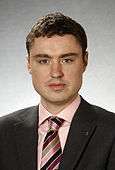 |
Taavi Rõivas (b. 1979) 17th Prime Minister |
26 March 2014 | 9 April 2015 | 973 | Reform Party (ERE) |
Rõivas I ERE–SDE | |||
| 9 April 2015 | 23 November 2016 | Rõivas II ERE–SDE–IRL |
XIII (2015) | ||||||
| President Kersti Kaljulaid (2016–incumbent) | |||||||||
 |
Jüri Ratas (b. 1978) 18th Prime Minister |
23 November 2016 | Incumbent | 689 | Centre Party (EKE) |
Ratas EKE–SDE–IRL EKE–SDE–I [Note 23] | |||
Statistics
Time in office
A total of 23 people have headed the Government of Estonia, 15 before and 8 after the Soviet occupation. Konstantin Päts headed the government for the longest, a total of 3,563 days during six different terms (2,059 days without his authoritarian era). Andrus Ansip is the second longest office holder, having been democratically in office longer than Päts.
The shortest time in office was for Ado Birk, when he served as Prime Minister for only 3 days and never actually stepping into office. Acting Prime Minister Otto Tief was in office for 8 days between the German and Soviet occupations in 1944. Ants Piip, August Rei, Jüri Uluots, Juhan Kukk, Friedrich Karl Akel and Jüri Jaakson were also in office for less than a year.
Number and length of terms
Konstantin Päts served a total of six terms, although his sixth term turned into an authoritarian regime. Jaan Tõnisson was in office four times, although there was just one full day of Ado Birk's cabinet between his first two terms. Otto August Strandman, Jaan Teemant, Karl August Einbund (named Kaarel Eenpalu during his second term in the semi-authoritarian era), Tiit Vähi (first term during the interim period) and Mart Laar all served two terms in office.
Longest average term lengths are all in the reindependence period with Andrus Ansip in the lead (3,271 days), Mart Laar second (895 days) and Mart Siimann third (739 days). Longest interwar average term is held by Konstantin Päts (594 days). During the interwar democratic era however, longest average term was achieved by Jaan Teemant (439 days), followed by Otto August Strandman (389 days) and by Konstantin Päts himself (383 days).
The era before occupation had the shortest average term lengths with the two extremes of Ado Birk (3 days) and Otto Tief (8 days), but also Ants Piip with 92 days. Jaan Tõnisson also had an average term length of only 216 days. Andres Tarand (with 161 days) and Siim Kallas (with 438 days) have the shortest average term lengths during the reindependence era.
Age at assuming office
Mart Laar was only 32 years old when he became Prime Minister in 1992. Ado Birk, Ants Piip, Juhan Kukk, Taavi Rõivas, Edgar Savisaar, Mart Laar (2nd term in 1999) and Juhan Parts were also in their 30s when appointed. Jaan Tõnisson was 64 when stepping into office in 1933. The rest were in their 40s or 50s when assuming office, average age at appointment is 48.

Notes
- ↑ The Estonian Social Democratic Workers' Party (ESDTP) joined the coalition on 16 November 1918.
- ↑ The German Party in Estonia (SEE) joined the coalition on 28 November 1918. The Russian Citizens' Assembly (VKK) joined the coalition on 28 February 1919. The Estonian Democratic Party (EDE) merged with the Estonian Radical Democratic Party (ERDE) to form the Estonian People's Party (ERE) on 1 March 1919 and the new party remained in the government.
- ↑ The Estonian People's Party (ERE) left the coalition on 20 September 1919.
- ↑ Estonian Social Democratic Workers' Party (ESDTP) left the coalition on 1 July 1920, but its ministers remained in office.
- ↑ The Estonian Labour Party (ETE) left the coalition on 13 October 1921. Its ministers resigned on 20 October 1921.
- ↑ The Minister of Internal Affairs Karl August Einbund, the only representative of the Estonian People's Party (ERE) in the coalition, left the party on 5 March 1923. His former party decided to remain in the coalition without any ministerial positions.
- ↑ The Estonian Social Democratic Workers' Party (ESDTP) merged with the Independent Socialist Workers' Party (ISTP) and formed the Estonian Socialist Workers' Party (ESTP) on 9 April 1925 and the new party remained in the government.
- 1 2 As Karl August Einbund Estonianized his name into Kaarel Eenpalu, his two cabinets are therefore known as Einbund I and Eenpalu II cabinets.
- ↑ All political parties were banned on 20 March 1935.
- 1 2 Although Konstantin Päts resigned as President-Regent on 24 April 1938 to become the President on the same day, his cabinet remained temporarily in office until 9 May 1938, headed by acting Prime Minister Kaarel Eenpalu.
- 1 2 3 Was member of the Patriotic League which was the only sanctioned political organization, but which cannot be considered a political party per se.
- ↑ The "Era of Silence" began with Konstantin Päts' self-coup on 21 March 1934. The Riigikogu approved of the coup retroactively on 15 March 1934. The Riigikogu was thereafter not convened after 2 October 1934. It was officially disbanded on 1 January 1938.
- ↑ The Soviet Union occupied Estonia on 17 June 1940. The Soviet regime staged a pro-Soviet coup d'état on 21 June 1940, replacing the Jüri Uluots cabinet with that of Johannes Vares. The Republic of Estonia does not consider the Johannes Vares cabinet a legal government of Estonia and considers the Jüri Uluots cabinet to have legally remained in office until 18 September 1944.
- ↑ Prime Minister in the duties of the President Jüri Uluots appointed a new government after the departure of German forces, hoping to restore Estonian independence before the arrival of Soviet forces.
- ↑ The Soviet Union occupied Estonia on 17 June 1940. The Soviet regime staged a pro-Soviet coup d'état on 21 June 1940, replacing the Jüri Uluots cabinet with that of Johannes Vares. The Republic of Estonia does not consider the Johannes Vares cabinet a legal government of Estonia and considers the Jüri Uluots cabinet to have legally remained in office until 18 September 1944.
- ↑ The legal Prime Minister Jüri Uluots assumed the role of Prime Minister in the duties of the President on 18 September 1944, after the departure of German forces and before the arrival of Soviet forces.
- ↑ The Supreme Soviet of the Estonian SSR on 30 March 1990 declared Soviet rule to have been illegal since 1940 and declared a transition period for full independence. Full independence was restored on 20 August 1991.
- ↑ The Popular Front of Estonia formed the Estonian People's Centre Party on 12 October 1991.
- 1 2 The "Estonian Soviet Socialist Republic" was renamed the "Republic of Estonia" on 8 May 1990 and thus the translation of the "Supreme Soviet" was changed to "Supreme Council".
- 1 2 3 President left the party upon assuming office.
- ↑ The electoral alliance "Pro Patria" formed the Pro Patria National Coalition Party on 21 November 1992.
- 1 2 3 The electoral alliance "Moderates" (M) consisted of the Social Democratic Party (ESDP) and the Estonian Rural Centre Party (EMKE).
- ↑ The Union of Pro Patria and Res Publica was renamed Party Pro Patria on 2 June 2018.
